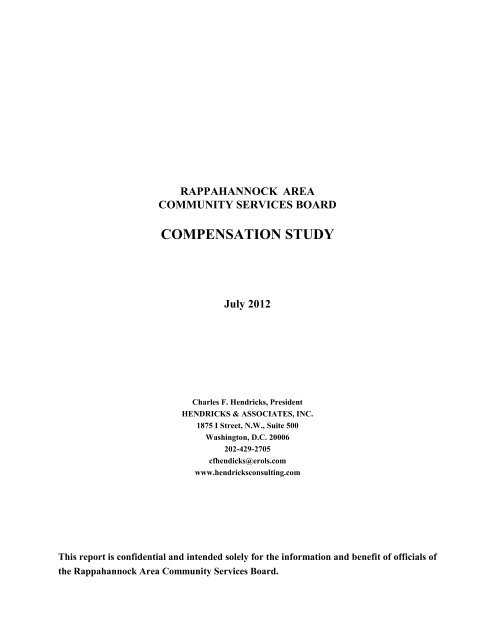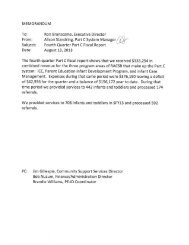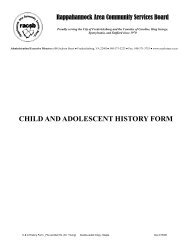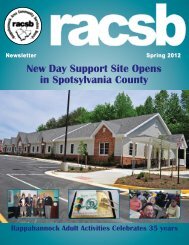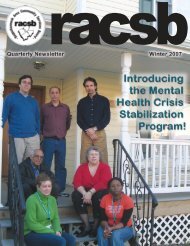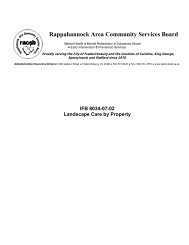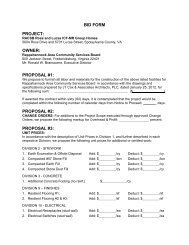View Attachment - Rappahannock Area Community Services Board
View Attachment - Rappahannock Area Community Services Board
View Attachment - Rappahannock Area Community Services Board
You also want an ePaper? Increase the reach of your titles
YUMPU automatically turns print PDFs into web optimized ePapers that Google loves.
RAPPAHANNOCK AREA<br />
COMMUNITY SERVICES BOARD<br />
COMPENSATION STUDY<br />
July 2012<br />
Charles F. Hendricks, President<br />
HENDRICKS & ASSOCIATES, INC.<br />
1875 I Street, N.W., Suite 500<br />
Washington, D.C. 20006<br />
202-429-2705<br />
cfhendicks@erols.com<br />
www.hendricksconsulting.com<br />
This report is confidential and intended solely for the information and benefit of officials of<br />
the <strong>Rappahannock</strong> <strong>Area</strong> <strong>Community</strong> <strong>Services</strong> <strong>Board</strong>.
Chapter<br />
RAPPAHANNOCK AREA COMMUNITY SERVICES BOARD<br />
COMPENSATION STUDY<br />
Table of Contents<br />
Page<br />
EXECUTIVE SUMMARY<br />
Objectives and Approach I<br />
Principal Recommendations I<br />
Implementation<br />
ii<br />
I<br />
II<br />
III<br />
IV<br />
V<br />
INTRODUCTION<br />
Objectives and Scope 1<br />
Study Approach 2<br />
Report Arrangement 3<br />
INTERNAL EQUITY<br />
Position Classification 4<br />
Job Evaluation 4<br />
Salary Grade Determination 6<br />
FLSA Determination 6<br />
EXTERNAL COMPETITIVENESS<br />
Compensation Survey 10<br />
Competitive Salary Rates 11<br />
Proposed Salary Ranges 13<br />
Benefits 14<br />
ADMINISTRATION AND MAINTENANCE<br />
Salary Administration 15<br />
Salary/Midpoint Concept 15<br />
Merit (Performance) Increase 15<br />
Plan Maintenance 16<br />
Updating Salary Ranges 17<br />
IMPLEMENTATION<br />
Implementation Costs 18<br />
Next Steps 18
RAPPAHANNOCK AREA COMMUNITY SERVICES BOARD<br />
COMPENSATION STUDY<br />
Table of Exhibits<br />
Exhibit Page<br />
1 Job Evaluation Factors 5<br />
2 Proposed Grade Assignments 7<br />
3 Compensation Survey Participants 11<br />
4 Competitive Salaries 12<br />
5 Proposed Salary Ranges 13
EXECUTIVE SUMMARY<br />
&<br />
&<br />
&<br />
Objectives and Approach<br />
Principal Recommendations<br />
Implementation
RAPPAHANNOCK AREA COMMUNITY SERVICES BOARD<br />
EXECUTIVE SUMMARY<br />
The overall purpose of the study has been to update the classification and compensation plan of the<br />
<strong>Rappahannock</strong> <strong>Area</strong> <strong>Community</strong> <strong>Services</strong> <strong>Board</strong> (RACSB). More specific objectives were to ensure<br />
that employees are:<br />
&<br />
&<br />
&<br />
Appropriately titled and graded in relationship to specific job duties;<br />
Paid at salary ranges competitive with other <strong>Community</strong> Service <strong>Board</strong>s (CSB’s), other<br />
behavioral health providers and local public sector employers.<br />
Motivated - individually and collectively - to strive to meet and exceed RACSB goals.<br />
The scope of the review included approximately 438 full and part time employees filling 113<br />
position classifications. The principal tasks included:<br />
&<br />
&<br />
&<br />
Employees’ completion of a position questionnaire, describing their duties and<br />
responsibilities and interviews with a sample of RACSB employees.<br />
Design and application of a quantitative job evaluation plan to ensure internal equity among<br />
employees.<br />
A survey of the salaries and benefits.<br />
PRINCIPAL RECOMMENDATIONS<br />
1. Assign employees to RACSB’s to a new 20-grade structure. <strong>Rappahannock</strong> <strong>Area</strong> <strong>Community</strong><br />
<strong>Services</strong> <strong>Board</strong> positions have been reassigned to one of the 20 grades on the basis of points<br />
received for designated job factors.<br />
2. Update RACSB salary ranges to continue to provide employees opportunities for<br />
advancement based on performance. The ranges proposed are competitive and are based on the<br />
salaries paid to similar positions in other comparable community service boards. Under the new<br />
range schedule, the differential between minimums, midpoints and maximums of the various grade<br />
levels approximates 9.8% which provides a reward to employees promoted from one grade level to<br />
the next. The range depth (the percentage differential from minimum to maximum of each range)<br />
approximates 67% provide opportunities for salary advancement based on performance.<br />
3. Provide ways to relate salary advancement to competitive market conditions and individual<br />
performance. RACSB should use the "open range" pay plan where the concept of "salary/midpoint"<br />
is based on the relationship of employee salaries to the midpoint of their salary ranges (or the market<br />
i<br />
HENDRICKS & ASSOCIATES, INC.
RAPPAHANNOCK AREA COMMUNITY SERVICES BOARD<br />
rate) and their individual performance.<br />
IMPLEMENTATION<br />
The cost to implement the new pay ranges for full-time and part-time employees is approximately<br />
$28 thousand, or less than .1% of payroll. However, this is only the cost to raise full-time employee’s<br />
salaries to range minimums. A more realistic cost factor is 3% of total payroll to insure that <strong>Board</strong><br />
salaries remain competitive with other <strong>Community</strong> Serviced <strong>Board</strong>s and local employers.<br />
The RACSB <strong>Board</strong> should review the report in detail before accepting it in principle. Acceptance<br />
in principle means agreement with the overall intent of the recommendations even though there may<br />
be questions on specific details.<br />
ii<br />
HENDRICKS & ASSOCIATES, INC.
I - INTRODUCTION<br />
&<br />
&<br />
&<br />
Objectives and Scope<br />
Study Approach<br />
Report Arrangement
RAPPAHANNOCK AREA COMMUNITY SERVICES BOARD<br />
I. INTRODUCTION<br />
This report presents the results of a classification and compensation study of RACSB. This<br />
introductory chapter outlines the objectives and scope of the study, describes the approach used, and<br />
sets forth the arrangement of the report.<br />
OBJECTIVES AND SCOPE<br />
The <strong>Rappahannock</strong> <strong>Area</strong> <strong>Community</strong> <strong>Services</strong> <strong>Board</strong> (RACSB), a local government agency which<br />
was established in 1970 under Subtitle II, Chapter 5 of the Code of Virginia, is composed of fifteen<br />
volunteer members who are appointed by the local governing bodies. The RACSB provides mental<br />
health, intellectual disability, substance abuse, prevention, and early intervention services to the<br />
residents of five political jurisdictions in Virginia – the City of Fredericksburg and Counties of<br />
Caroline, King George, Spotsylvania and Stafford. It operates programs at 30 site locations<br />
throughout the catchment area.<br />
The RACSB was interested in updating its classification and compensation system to ensure it will<br />
be able to attract and retain high caliber employees and remain competitive in its marketplace. At<br />
this time, RASCB was seeking qualified contractors to provide a classification and compensation<br />
study. The study outcome will result in a new classification and compensation plan, updated<br />
position descriptions, policies and procedures, audit capability for future classification actions and<br />
related management/supervisory training, and to ensure our compensation reflects trends in our<br />
geographic market and industry, while being cognizant of limited resources in order to compete with<br />
similar agencies and private providers to attract and retain qualified candidates. More specific<br />
objectives were to:<br />
&<br />
&<br />
&<br />
&<br />
&<br />
Conduct a thorough and in-depth survey of total compensation program, including wages,<br />
benefits and supplements through interviews; questionnaires from similarly placed agencies<br />
and private providers in and around the greater RACSB service area, the region, and<br />
nationally; and reviews of classification and pay plans.<br />
Conduct interviews as needed to gather relevant information.<br />
Evaluate Agency positions and classifications and the provisions of application laws,<br />
regulations, and procedures governing the plan to include EEO, ADAA, and FLSA.<br />
Determine exempt-non-exempt status per the Fair Labor Standards Act of all positions<br />
included in the study and provide an action plan and budget estimates for any positions that<br />
may move from exempt to nonexempt status, or vice versa.<br />
Revise Agency position descriptions to reflect outcomes of the work.<br />
1<br />
HENDRICKS & ASSOCIATES, INC.
RAPPAHANNOCK AREA COMMUNITY SERVICES BOARD<br />
&<br />
&<br />
&<br />
&<br />
&<br />
&<br />
Revise RACSB compensation and classification policies and procedures to reflect outcomes<br />
of the work and to provide an audit mechanism for RACSB’s use in future classification and<br />
compensation actions.<br />
Analyze means available for recruiting and retaining qualified candidates to RACSB while<br />
maintaining equitable compensation levels for the incumbent staff.<br />
Prepare and submit a final report which describes the classification and pay plan and<br />
recommended implementation of procedures and the procedures for continuing maintenance<br />
and administration of the plan. The report will describe the procedures followed in<br />
developing the plan, summarize, and explain proposed changes, including copies of all class<br />
specifications by occupational groupings.<br />
Provide training and support for implementation of the results of the work, revised policies<br />
and procedures, and audit mechanisms.<br />
Present and explain the contents of the final report to various groups including the Executive<br />
Director, Human Resource Manager; Senior Staff; and the Personnel Committee of the<br />
<strong>Board</strong> of Directors.<br />
Provide legal support and defense, to include serving as an expert witness, for claims which<br />
may arise as a result of the outcome of the classification and compensation plan and its<br />
implementation.<br />
The scope of the review included approximately 438 full and part time employees filling 113<br />
position classifications.<br />
STUDY APPROACH<br />
Early in the study available documents and data on existing compensation arrangements were<br />
assembled and reviewed. These materials included salary schedules, job specifications,<br />
organizational charts, salary supplements and benefit plans, and other materials. Each employee was<br />
requested to update the six-page position questionnaire describing the duties and responsibilities of<br />
his or her position. Most RACSB workers completed the position questionnaire with participation<br />
from every RACSB division and department.<br />
Interviews were conducted with RACSB directors, coordinators, and managers to obtain information<br />
concerning the RACSB’s functions, the relationships of the various positions being studied, and their<br />
opinions on internal equity and external competitiveness. These interviews provided a broad and indepth<br />
understanding of the functions, responsibilities, and other factors relevant to all positions.<br />
Using information from the completed questionnaires and interviews, employees were reassigned<br />
2<br />
HENDRICKS & ASSOCIATES, INC.
RAPPAHANNOCK AREA COMMUNITY SERVICES BOARD<br />
to the appropriate class title. The existing job evaluation plan was updated and applied to ensure<br />
equity across and within various pay schedules. Simultaneously, a compensation survey was<br />
conducted of comparable positions in other <strong>Community</strong> Service <strong>Board</strong>s (CSB’s), other behavioral<br />
health providers and local public sector employers. Survey questionnaires, which included<br />
descriptions of benchmark classes, were sent to these outside organizations to obtain salary<br />
information. Competitive salary trend lines were developed following statistical analysis of the<br />
survey data obtained. These trend lines represented the prevailing market salaries for positions at<br />
each proposed grade level.<br />
New salary ranges were developed on the basis of the job evaluation results and the compensation<br />
survey. Salary administration policies and procedures for the salary plan were also developed and<br />
costs of implementation were estimated. Finally, this report was prepared to document the study's<br />
recommendations.<br />
REPORT ARRANGEMENT<br />
Following this introductory chapter, this report has four additional chapters and three appendices:<br />
&<br />
&<br />
&<br />
&<br />
II. Internal Equity: describes major steps taken to classify, evaluate and grade jobs and to<br />
determine salary grade assignments.<br />
III. External Competitiveness: presents the results of the analysis of compensation survey<br />
data for comparable positions, the comparative salary trend lines, and the proposed ranges.<br />
IV. Administration and Maintenance: discusses how to administer and maintain the<br />
system.<br />
V. Implementation: suggests next steps to implement the proposed compensation plan.<br />
The three appendices are:<br />
&<br />
&<br />
&<br />
Appendix A Proposed Class Titles<br />
Appendix B Job Evaluation Plan<br />
Appendix C Benefit Survey Results<br />
3<br />
HENDRICKS & ASSOCIATES, INC.
II - INTERNAL EQUITY<br />
&<br />
&<br />
&<br />
&<br />
Position Classification<br />
Job Evaluation<br />
Salary Grade Determination<br />
FLSA Determination
RAPPAHANNOCK AREA COMMUNITY SERVICES BOARD<br />
II. INTERNAL EQUITY<br />
This chapter outlines the principal steps taken in assigning RACSB employees to class titles, and in<br />
evaluating and grading these class titles to ensure internal equity.<br />
POSITION CLASSIFICATION<br />
A key objective has been to update job titles that reflects the RACSB’s specific work requirements.<br />
To update the title structure to fit the RACSB, position questionnaires were completed by employees<br />
and interviews were conducted to provide up-to-date information on the duties, responsibilities and<br />
qualifications required for all positions. An alphabetical list of RACSB Classes is contained as<br />
Appendix A to this report.<br />
JOB EVALUATION<br />
The existing job evaluation plan was reviewed comparing the duties and responsibilities of <strong>Board</strong><br />
positions to selected quantifiable criteria (i.e., job evaluation factors). The seven existing evaluation<br />
factors were applied again to all classes; these factors were: Job Complexity, Education/Experience,<br />
Scope and Impact, Supervision Received, Working Relationships, Working Environment, and<br />
Physical Demands. The factor definitions are found in Exhibit 1. Appendix B further describes the<br />
proposed job evaluation plan<br />
The same evaluation weights were again applied to each factor to reflect its relative importance. The<br />
following table shows the evaluation weights (expressed as a percentage of the total) established for<br />
the seven evaluation factors.<br />
Factor<br />
Weight<br />
Job Complexity 30.0%<br />
Education/Experience 10.0<br />
Scope and Impact 30.0<br />
Supervision Received 10.0<br />
Working Relationships 15.0<br />
Working Environment 3.0<br />
Physical Demands 2.0<br />
100%<br />
4<br />
HENDRICKS & ASSOCIATES, INC.
RAPPAHANNOCK AREA COMMUNITY SERVICES BOARD<br />
JOB EVALUATION FACTORS<br />
Exhibit 1<br />
JOB COMPLEXITY: This factor covers the nature, number, variety, and intricacy of tasks,<br />
steps, process, or methods in the work performed; the difficulty in identifying what needs to<br />
be done; and the difficulty and originality involved in performing the work. This factor also<br />
covers the judgment needed to apply guidelines, the nature of guidelines, and authority to<br />
depart from and to adopt guides.<br />
EDUCATION AND EXPERIENCE: This factor measures the combination of formal<br />
education, training and practical experience needed to fully perform the requirements of the<br />
job.<br />
SCOPE AND IMPACT: This factor covers the purpose, breadth, and depth of the<br />
assignment, and the effect of work products or services both within and outside the<br />
organization.<br />
SUPERVISION RECEIVED: This factor covers the nature and extent of direct or indirect<br />
controls exercised by the supervisor, the employee's responsibility, and the review of<br />
completed work. Controls are exercised by the supervisor in the way assignments are made,<br />
instructions are given to the employee, priorities and deadlines are set, and objectives and<br />
boundaries are defined.<br />
WORKING RELATIONSHIPS: This factor refers to the responsibility to deal with<br />
individuals or groups, such as representatives of organizations, legislative bodies, or<br />
community groups to accomplish work objectives. Consideration is given to the purpose of<br />
contacts, their difficulty, importance, and level within or outside the organization.<br />
WORK ENVIRONMENT: This factor measures the discomforts or unpleasantness of the<br />
work environment. Frequency of exposure to unpleasant or discomforting conditions is<br />
considered. This factor also considers the hazards present on the job even though all<br />
reasonable safety precautions have been taken.<br />
PHYSICAL DEMANDS: This factor covers the requirements and physical demands placed<br />
on the employee by the work assignment. This includes physical characteristics and abilities<br />
and the physical exertion involved in the work. The frequency or intensity of physical<br />
exertion is also considered.<br />
5<br />
HENDRICKS & ASSOCIATES, INC.
RAPPAHANNOCK AREA COMMUNITY SERVICES BOARD<br />
Each RACSB job was compared with all other jobs, one factor at a time. Each comparison is limited<br />
to the specific characteristics of the factor being considered. For example, for the factor "Scope and<br />
Impact," each class was ranked as specifically and concretely as possible in terms of the range of<br />
opportunity to affect or influence results; on the other hand, the factor "Supervision Received"<br />
measures constraints on (or conversely, latitude for) decision-making. This process resulted in<br />
establishing relative levels or ranks for all classes on each of the factors. Although each level<br />
represents a significant difference from the level above and the level below, it is not defined as<br />
possessing some absolute amount of the characteristics relative to all other classes. The numbers of<br />
evaluation levels are not preestablished but are determined entirely by the comparison ranking<br />
process. Classes considered equivalent were grouped at the same level. After grouping the classes,<br />
the factor level was recorded for each classification. The same process for assigning ranking levels<br />
was repeated for each of the other factors. Next, evaluation point scores were assigned to each level<br />
for each factor. The points assigned were computed to reflect the relative weights of each factor.<br />
SALARY GRADE<br />
DETERMINATION<br />
After each class was assigned weighted evaluation points, evaluation point scores for each class were<br />
added to produce a total weighted point score. The total weighted points were numerical<br />
representations of the relative value of RACSB classes, which formed the basis for grouping classes<br />
of comparable value into position grades. The total weighted points were reviewed to determine the<br />
number of salary grades needed to differentiate among the classes. To validate the current number<br />
of salary grades, the following criteria were used:<br />
&<br />
&<br />
Each salary grade should include only classes of comparable value.<br />
A sufficient number of grades should be created to cover all organizational and supervisory<br />
levels within the RACSB's departments.<br />
On the basis of these general principles, various grade groupings were tested and the 20-grade<br />
structure was retained. The resulting assignment of classes to salary grades is presented on Exhibit<br />
2 following this page.<br />
FLSA DETERMINATION<br />
As part of the study, it was necessary to designate each position as either exempt or nonexempt from<br />
the overtime provisions of the Fair Labor Standards Act (FLSA). Given these criteria, it is<br />
recommended that employees in Grades 9 and above of the proposed ranges should be considered<br />
exempt (i.e., not eligible for overtime pay).<br />
6<br />
HENDRICKS & ASSOCIATES, INC.
PROPOSED GRADE ASSIGNMENTS<br />
Exhibit 2<br />
Page 1 of 3<br />
Salary Grade<br />
Proposed Class Title<br />
20 Executive Director<br />
18 Clinical <strong>Services</strong> Director<br />
<strong>Community</strong> Support <strong>Services</strong> Director<br />
Finance/Administration Director<br />
16 Clinic Coordinator III<br />
Emergency <strong>Services</strong> Coordinator<br />
15 Clinic Coordinator II<br />
Crisis Stabilization Program Coordinator<br />
Day Support Coordinator<br />
Human Resources Manager<br />
ID Residential Program Coordinator<br />
IT Coordinator<br />
MH Residential Coordinator<br />
MH/ID Case Management Coordinator<br />
PEID Coordinator<br />
Psychiatric Nurse Practitioner<br />
14 Clinic Coordinator I<br />
Healthy Families Program Coordinator<br />
Psychologist III (Licensed, Ph.D./Psy.D.)<br />
Psychosocial Program Coordinator<br />
Quality Assurance Coordinator<br />
Reimbursement Coordinator<br />
Substance Abuse Coordinator<br />
13 Accounting Coordinator<br />
Assistant IT Coord/Project Manager<br />
Crisis Stabilization Program Assistant Coordinator<br />
ID Supervised Apartment Supervisor<br />
ID Supported Living/Sponsored Placement Spvr<br />
Intensive In-Home Svcs Supervisor<br />
Jail/Detention <strong>Services</strong> Supervisor<br />
Juvenile Drug Court Supervisor<br />
MH Supervised Apartment Supervisor<br />
Occupational Therapist<br />
Physical Therapist<br />
Property Supervisor<br />
Psychologist II (licensed, no Ph.D.)
Salary Grade<br />
Proposed Class Title<br />
Exhibit 2<br />
Page 2 of 3<br />
13 (Cont) Public Information Officer<br />
Speech Pathologist<br />
Wounded Warrior Program Manager<br />
12 CIT Program Manager<br />
Detention-based Therapist<br />
Emergency <strong>Services</strong> Therapist<br />
Group Home Manager<br />
Healthy Families Supervisor<br />
Intensive In-Home Therapist (Homebuilder)<br />
MH Supervised Apartment Mgr.<br />
MH/SA Therapist<br />
Prevention <strong>Services</strong> Program Manager<br />
SA/MH Therapist (Licensed)<br />
Special Educator<br />
Therapist (Licensed)<br />
Therapist-Juvenile Drug Court Detention-Based<br />
11 Child/Adolescent Case Manager<br />
Day Support Ass't. Coordinator (ID)<br />
Horticultural Specialist<br />
ID Supports Coordinator<br />
Infant/Child Support Coordinator<br />
Intensive Care Case Manager<br />
LINK Program Manager<br />
MH Nurse<br />
Parent Educator<br />
PATH Outreach/Liaison to Central Hosp<br />
SA Case Manager<br />
Therapist-Unlicensed<br />
Utilization Review Specialist<br />
Utilization Review/Consumer Affairs<br />
Vocational Manager/Ass't Program Coordinator<br />
10 Accounting Specialist<br />
ICC Specialist<br />
ID Residential Specialist-SLSP<br />
Internal Auditor<br />
IT Specialist<br />
Prevention Specialist<br />
Transportation Supervisor<br />
Wounded Warrior Peer Specialist
Salary Grade<br />
Proposed Class Title<br />
Exhibit 2<br />
Page 3 of 3<br />
9 Executive Associate<br />
Kids On The Block Specialist<br />
Lead Day Support Specialist<br />
MH Residential Specialist<br />
Residential Counselor II<br />
VICAP Assessment Specialist<br />
8 Account Technician II<br />
Accounting Specialist/Property Manager<br />
Day Support Specialist<br />
Family Resource Specialist<br />
Family Support Worker<br />
LINK Specialist<br />
Office Manager II<br />
Psychosocial Advocate<br />
Purchasing Specialist<br />
Reimbursement Technician III<br />
7 Administrative Office Associate<br />
Data Specialist<br />
Drug Court Surveillance<br />
Human Resources Associate<br />
In-Home Counselor<br />
Office Manager I<br />
Surveillance Office-Drug Court<br />
6 Day Support Counselor (ID)<br />
Juvenile Drug Court Mentor<br />
Office Associate II<br />
Property Maintenance Technician<br />
Reimbursement Technician II<br />
Residential Counselor I<br />
5 Cook<br />
Data Entry Clerk<br />
Day Support Aide (ID)<br />
Medical Records Clerk<br />
Peer Coach<br />
Residential Aide<br />
Van Driver<br />
4 Office Associate I
III - EXTERNAL COMPETITIVENESS<br />
&<br />
&<br />
&<br />
&<br />
Compensation Survey<br />
Competitive Salary Rates<br />
Proposed Salary Ranges<br />
Benefits
RAPPAHANNOCK AREA COMMUNITY SERVICES BOARD<br />
III. EXTERNAL COMPETITIVENESS<br />
A primary objective of the project was the development of salary ranges that are externally<br />
competitive, so RACSB can recruit, motivate, and retain capable employees. After completing the<br />
evaluation and grading processes to establish internal equity, externally competitive salary ranges<br />
were determined. This chapter presents and discusses the development of the recommended salary<br />
ranges.<br />
COMPENSATION SURVEY<br />
The proposed salary ranges were based on a compensation survey of comparable positions in other<br />
<strong>Community</strong> Service <strong>Board</strong>s (CSB’s), other behavioral health providers and the local market in<br />
general. Survey questionnaires, which included descriptions of benchmark classes, were sent to these<br />
outside organizations to obtain salary information. Benchmark classes were selected on the basis of:<br />
&<br />
&<br />
&<br />
&<br />
Comparability to other organizations,<br />
Representation of various grade levels,<br />
Inclusion of a cross section of positions,<br />
Coverage of significant classes with large numbers of employees.<br />
Survey questionnaires were mailed to organizations selected according to these criteria:<br />
&<br />
&<br />
&<br />
Geographic proximity to the RACSB work force,<br />
Functional comparability,<br />
Representation of various labor markets.<br />
The survey questionnaire included a brief description of the duties and responsibilities of each<br />
benchmark class to ensure comparability of job content as well as information on benefits. Data<br />
provided by these organizations were tabulated and studied using computer-based statistical analysis<br />
techniques. The surveyed organizations, listed in Exhibit 3, consisted of other local employers and<br />
other <strong>Community</strong> Service <strong>Board</strong>s.<br />
10<br />
HENDRICKS & ASSOCIATES, INC.
RAPPAHANNOCK AREA COMMUNITY SERVICES BOARD<br />
COMPENSATION SURVEY PARTICIPANTS<br />
Exhibit 3<br />
Alexandria <strong>Community</strong> <strong>Services</strong> <strong>Board</strong><br />
Arlington County <strong>Community</strong> <strong>Services</strong> <strong>Board</strong><br />
Fairfax-Falls Church <strong>Community</strong> <strong>Services</strong> <strong>Board</strong><br />
Hanover County <strong>Community</strong> <strong>Services</strong><br />
Henrico <strong>Area</strong> Mental Health & Developmental <strong>Services</strong> <strong>Board</strong><br />
Prince William <strong>Community</strong> <strong>Services</strong> <strong>Board</strong><br />
<strong>Rappahannock</strong> Rapidan <strong>Community</strong> <strong>Services</strong> <strong>Board</strong><br />
Richmond Behavioral Health Authority<br />
City of Fredericksburg<br />
Fredericksburg City Schools<br />
Mary Washington Health Care<br />
Spotsylvania County<br />
Spotsylvania Public Schools<br />
Stafford County<br />
Stafford County Public Schools<br />
COMPETITIVE SALARY RATES<br />
Competitive salary rates were determined for each salary grade. To determine competitiveness,<br />
several salary trend lines were calculated in order to compare RACSB's present salary levels to the<br />
organizations surveyed. A "salary trend line" is a mathematical curve portraying the average of the<br />
surveyed benchmark midpoint salaries. In essence, a salary trend line is the "best fit" of the survey<br />
data. The salary trend lines are presented in Exhibit 4, which is a scatter diagram comparing annual<br />
salaries to the benchmark positions which would fall into the 20 proposed salary grades. Exhibit 4<br />
shows four lines:<br />
&<br />
&<br />
The lowest line ("solid square" marker) are the current RACSB midpoints.<br />
The highest line (“solid upward triangle” marker) represents the average of range midpoints<br />
for the local employers.<br />
11<br />
HENDRICKS & ASSOCIATES, INC.
Exhibit 4
RAPPAHANNOCK AREA COMMUNITY SERVICES BOARD<br />
&<br />
&<br />
The next line (‘solid downward triangle” marker represents the averages of the midpoints for<br />
the other CSB’s.<br />
The final converging "solid line” with no marker represents the range midpoints proposed<br />
for RACSB.<br />
The ranges proposed are competitive and are based on the salaries paid to similar positions in other<br />
community service boards,<br />
PROPOSED SALARY RANGES<br />
The recommended trend line represents the control points for the proposed salary ranges presented<br />
in Exhibit 5.<br />
RECOMMENDED SALARY RANGES Exhibit 5<br />
Grade Minimum Midpoint Maximum<br />
20 $101,868 $136,448 $171,002<br />
19 92,820 124,280 155,740<br />
18 84,578 113,230 141,856<br />
17 77,064 103,142 129,194<br />
16 70,226 93,964 117,676<br />
15 63,986 85,592 107,172<br />
14 58,292 77,974 97,630<br />
13 53,118 71,032 88,920<br />
12 48,412 64,714 80,990<br />
11 44,096 58,942 73,762<br />
10 40,170 53,690 67,184<br />
9 36,608 48,906 61,178<br />
8 33,358 44,564 55,744<br />
7 30,394 40,586 50,752<br />
6 27,690 36,972 46,228<br />
5 25,246 33,696 42,120<br />
4 22,984 30,680 38,350<br />
3 20,956 27,950 34,944<br />
2 19,084 25,454 31,824<br />
1 17,394 23,192 28,990<br />
13<br />
HENDRICKS & ASSOCIATES, INC.
RAPPAHANNOCK AREA COMMUNITY SERVICES BOARD<br />
The ranges were constructed to include the following characteristics:<br />
&<br />
&<br />
&<br />
Salary midpoints of the proposed ranges approximate competitive compensation levels in the<br />
market (i.e., the recommended trend line of Exhibit 4).<br />
The range depth (that is, the percentage differential from minimum to maximum of each<br />
range) approximates 67 percent which provides opportunity for salary advancement based<br />
on performance or growth in the position.<br />
The differential between minimums, midpoints and maximums of the various grade levels<br />
is approximately 9.8% which provides a reward to employees promoted from one grade<br />
level.<br />
BENEFITS<br />
Appendix C presents the results of the benefit portion of the survey. Overall, the RACSB’s benefits<br />
are on a par with the other organizations surveyed.<br />
14<br />
HENDRICKS & ASSOCIATES, INC.
IV - ADMINISTRATION AND MAINTENANCE<br />
&<br />
&<br />
&<br />
&<br />
&<br />
Salary Administration<br />
Salary/Midpoint Concept<br />
Merit (Performance) Increase<br />
Plan Maintenance<br />
Updating Salary Ranges
RAPPAHANNOCK AREA COMMUNITY SERVICES BOARD<br />
IV. ADMINISTRATION AND MAINTENANCE<br />
This chapter outlines specific policies and procedures for salary administration, evaluation plan<br />
maintenance, and range updating.<br />
SALARY ADMINISTRATION<br />
RACSB should administer salaries in a more flexible "open range" approach where the amount of<br />
salary increase varies depending on performance and position of salary within range. Under this<br />
"open range" plan, salary advancement should be based on employee performance and salary<br />
position within range (i.e., employees whose salaries are below range midpoint would receive a<br />
proportionately greater percentage increase than employees whose salaries are greater than range<br />
midpoint.) New employees would normally be hired at range minimums or, if necessary, in the first<br />
quartile (lower 25%) of the range. . However, depending on market conditions, employees could be<br />
brought in at higher rates subject to approval by the Executive Director.<br />
SALARY/MIDPOINT CONCEPT<br />
Under an "open range" system, the manner of salary administration is based on the relationship of<br />
employee salaries to the midpoint of their salary ranges (or the market rate as shown in the previous<br />
chapter). For example, a Grade 8 employee whose salary is $33,358 (the minimum of the Grade 8<br />
salary range) would have a "salary/midpoint" ratio of .75 (the employee's salary of $33,358 divided<br />
by the Grade 8 range midpoint of $44,564). To extend this example further, a Grade 8 employee<br />
whose salary was $55,744 (the Grade 8 maximum) would have a "salary/midpoint" ratio of 1.25; or<br />
if his/her salary was equal to the midpoint, the ratio would be equal 1.0 ($44,564/$44,564).<br />
The relevance of the salary midpoint concept is that salaries should be administered in such a way<br />
to accelerate salary advancement toward midpoint in order to be able to retain employees who might<br />
be attracted away to another organization at the competitive market (midpoint) rate. As an employee<br />
reaches and passes midpoint, the percentage salary increases should be declining because there is less<br />
likelihood that the person will leave once they are being paid above market levels.<br />
MERIT (PERFORMANCE) INCREASE<br />
Under the open range concept, employees should receive one annual salary adjustment which would<br />
take into consideration increases in market salaries as well as their performance. This would allow<br />
RACSB to be able to better budget for increases in RACSB payroll expenditures and ensure that<br />
budgeted resources are allocated to the most deserving employees. All employees would receive<br />
their performance increase at the same time to ensure that all employees are being treated uniformly.<br />
For example, a highly paid employee in Grade 8 should receive less of a percentage increase than<br />
a lower paid employee in the same grade if they both perform at the same level. This is because the<br />
15<br />
HENDRICKS & ASSOCIATES, INC.
RAPPAHANNOCK AREA COMMUNITY SERVICES BOARD<br />
more highly paid employee is already earning a premium over the lower paid employee and this<br />
difference should be mitigated if their work performance is considered the same.<br />
The Merit Increase Formula is as follows:<br />
Merit Increase = (Payroll Increase %) X Range Midpoint X (1 + (1-Sal/Midpt))<br />
To illustrate, if an employee's salary was $15,000 and the midpoint was $23,000, the employee<br />
would receive an increase of 10% when the average increase was 5%. [$1,550 = (5%) times $23,000<br />
times (1+(1-($15,000/$23,000)))] if they were meeting expectations.<br />
PLAN MAINTENANCE<br />
Over time duties and responsibilities of positions will change and new jobs will be created that could<br />
affect the internal alignment of classes. All newly established positions (and positions that undergo<br />
substantial changes in duties and responsibilities) should be reevaluated using the following process.<br />
When an incumbent's duties and responsibilities change substantially or if a new type of position is<br />
created, the employee (and/or supervisor) should initiate a review and complete a position<br />
questionnaire. The questionnaire should be reviewed and approved by the relevant department and<br />
sent to the Human Resource Department for analysis, classification, evaluation, and salary grade<br />
assignment. The Human Resource Manager should independently analyze the position, gathering<br />
information through job-site interviews and other means to develop a complete understanding of the<br />
duties, responsibilities, relationships, and working conditions of the position.<br />
If it is determined that the duties and responsibilities of the position are similar to those of positions<br />
in an existing class, the position should be given the class title and salary grade of the existing class.<br />
The department should be notified of the class title and grade. If the duties and responsibilities of<br />
the position are not similar to those of positions in an existing class, the department head may be<br />
requested to propose a new class title. The proposed class title should be submitted with the<br />
completed position questionnaire using the method described in this chapter. The resulting weighted<br />
points for each factor should be totaled to determine the appropriate salary grade.<br />
UPDATING SALARY RANGES<br />
The salary ranges proposed in this report should be reviewed at least every two years to determine<br />
the amount of adjustment, if any, needed to keep them current. Adjustments should be based on the<br />
results of a compensation survey which conforms to the methods used in this study, including use<br />
of the surveyed organizations and subsequent analytical procedures, as described in this report. The<br />
salary ranges proposed in this report should only be adjusted when a survey of area public and<br />
private sector employers indicates that the average increase of these employers was at least 3%.<br />
16<br />
HENDRICKS & ASSOCIATES, INC.
RAPPAHANNOCK AREA COMMUNITY SERVICES BOARD<br />
Under an “open range” plan, however, any future range adjustments would not immediately translate<br />
into a salary adjustment for employees since employees will no longer be on “steps.” The importance<br />
of the range adjustment is to ensure RACSB range structure stays competitive with the market as<br />
defined in Chapter III. In turn, employees will benefit because their “salary/midpoint” ratio will drop<br />
in proportion to the range adjustment thus providing opportunities to receive a proportionately larger<br />
merit increase assuming funding considerations and their performance warrant such a larger<br />
increase.<br />
17<br />
HENDRICKS & ASSOCIATES, INC.
V - IMPLEMENTATION<br />
&<br />
&<br />
Implementation Costs<br />
Next Steps
RAPPAHANNOCK AREA COMMUNITY SERVICES BOARD<br />
V. IMPLEMENTATION<br />
This chapter outlines implementation costs and suggests next steps to implement the proposed<br />
compensation plan.<br />
IMPLEMENTATION COSTS<br />
The cost to implement the new pay ranges for full-time and part-time employees is approximately<br />
$28 thousand, or less than .1% of payroll. However, this is only the cost to raise full-time employee’s<br />
salaries to range minimums. A more realistic cost factor is 3% of total payroll to insure that <strong>Board</strong><br />
salaries remain competitive with other <strong>Community</strong> Serviced <strong>Board</strong>s and local employers.<br />
NEXT STEPS<br />
It is recommended that the <strong>Board</strong> review the report in detail before accepting it in principle.<br />
Acceptance in principle means agreement with the overall intent of the recommendations, even<br />
though there may be questions on specific details.<br />
18<br />
HENDRICKS & ASSOCIATES, INC.
APPENDIX A: PROPOSED CLASS TITLES
A. PROPOSED CLASS TITLES<br />
Account Technician II<br />
Accounting Coordinator<br />
Accounting Specialist<br />
Accounting Specialist/Property Manager<br />
Administrative Office Associate<br />
Assistant IT Coord/Project Manager<br />
Child/Adolescent Case Manager<br />
CIT Program Manager<br />
Clinic Coordinator I<br />
Clinic Coordinator II<br />
Clinic Coordinator III<br />
Clinical <strong>Services</strong> Director<br />
<strong>Community</strong> Support <strong>Services</strong> Director<br />
Cook<br />
Crisis Stabilization Program Assistant Coord<br />
Crisis Stabilization Program Coordinator<br />
Data Entry Clerk<br />
Data Specialist<br />
Day Support Aide (ID)<br />
Day Support Ass't. Coordinator (ID)<br />
Day Support Coordinator<br />
Day Support Counselor (ID)<br />
Day Support Specialist<br />
Detention Based Therapist<br />
Drug Court Surveillance<br />
Emergency <strong>Services</strong> Coordinator<br />
Emergency <strong>Services</strong> Therapist<br />
Executive Associate<br />
Executive Director<br />
Family Resource Specialist<br />
Family Support Worker<br />
Finance/Administration Director<br />
Group Home Manager<br />
Healthy Families Program Coordinator<br />
Healthy Families Supervisor<br />
Horticultural Specialist<br />
Human Resources Associate<br />
Human Resources Manager<br />
ICC Specialist<br />
ID Residential Program Coordinator<br />
ID Residential Specialist-SLSP<br />
ID Supervised Apartment Supervisor<br />
ID Supported Living/Sponsored Placement<br />
Spvr<br />
ID Supports Coordinator<br />
Infant/Child Support Coordinator<br />
In-Home Counselor<br />
Intensive Care Case Manager<br />
Intensive In-Home Svcs Supervisor<br />
Intensive In-Home Therapist (Homebuilder)<br />
Internal Auditor<br />
IT Coordinator<br />
IT Specialist<br />
Jail/Detention <strong>Services</strong> Supervisor<br />
Juvenile Drug Court Mentor<br />
Juvenile Drug Court Supervisor<br />
Kids On The Block Specialist<br />
Lead Day Support Specialist<br />
LINK Program Manager<br />
LINK Specialist<br />
Medical Records Clerk<br />
MH Nurse<br />
MH Residential Coordinator<br />
MH Residential Specialist<br />
MH Supervised Apartment Mgr.<br />
MH Supervised Apartment Supervisor<br />
MH/ID Case Management Coordinator<br />
MH/SA Therapist<br />
Occupational Therapist<br />
Office Associate I<br />
Office Associate II<br />
Office Manager I<br />
Office Manager II<br />
Parent Educator<br />
PATH Outreach/Liaison to Central Hosp<br />
Peer Coach<br />
PEID Coordinator<br />
Physical Therapist<br />
Prevention <strong>Services</strong> Program Manager<br />
Prevention Specialist<br />
Property Maintenance Technician<br />
Property Supervisor<br />
Psychiatric Nurse Practitioner<br />
Psychologist II (licensed, no Ph.D.)<br />
Psychologist III (Licensed, Ph.D./Psy.D.)<br />
Psychosocial Advocate<br />
Psychosocial Program Coordinator<br />
Public Information Officer
Purchasing Specialist<br />
Quality Assurance Coordinator<br />
Reimbursement Coordinator<br />
Reimbursement Technician II<br />
Reimbursement Technician III<br />
Residential Aide<br />
Residential Counselor I<br />
Residential Counselor II<br />
SA Case Manager<br />
SA/MH Therapist (Licensed)<br />
Special Educator<br />
Speech Pathologist<br />
Substance Abuse Coordinator<br />
Surveillance Office-Drug Court<br />
Therapist (Licensed)<br />
Therapist-Juvenile Drug Court Detention-<br />
Based<br />
Therapist-Unlicensed<br />
Transportation Supervisor<br />
Utilization Review Specialist<br />
Utilization Review/Consumer Affairs<br />
Van Driver<br />
VICAP Assessment Specialist<br />
Vocational Manager/Ass't Program<br />
Coordinator<br />
Wounded Warrior Peer Specialist<br />
Wounded Warrior Program Manager
APPENDIX B: JOB EVALUATION PLAN
B. JOB EVALUATION PLAN<br />
The job evaluation plan proposed for the <strong>Rappahannock</strong> <strong>Area</strong> <strong>Community</strong> <strong>Services</strong> <strong>Board</strong> is a hybrid<br />
of the factor comparison and point factor methodologies. The strengths and limitations of these two<br />
methods are detailed below:<br />
&<br />
&<br />
Factor Comparison: Jobs are evaluated against each other; essentially a relative ranking<br />
system; factors, weights, and evaluation levels are tailored. Advantages: Works best in a<br />
situation where it is important to tailor the evaluation system to the needs of the organization,<br />
and development time and resources are limited. Limitations: Amount of documentation;<br />
considered subjective.<br />
Point Factor: Jobs are evaluated against absolute standards; evaluation factors, weights, and<br />
degree definitions are normally pre-established. Advantages: Works best in situations where<br />
there is a good fit between the point factor plan and the values of the organization; provides<br />
an appearance of objectivity. Limitations: Multi-factor plans are unwieldy and difficult to<br />
implement in a large and diverse organization; "off-the-shelf" plans typically do not "fit" the<br />
unique requirements of many organizations.<br />
The proposed hybrid approach combines the best features of the factor comparison and point factor<br />
methodologies and offers the following advantages:<br />
&<br />
&<br />
&<br />
Evaluation factors, factor weights, factor levels, and points are not preestablished like many<br />
traditional point factor plans, but are developed and tailored to fit an organization's unique<br />
set of requirements.<br />
The plan permits a greater degree of documentation (i.e. evaluation zones) than is found in<br />
conventional factor comparison approaches, thus ensuring greater objectivity and ease of<br />
communication.<br />
While providing a greater degree of technical precision, the approach is not unwieldy and can<br />
be implemented and maintained without any additional staff resources.<br />
The proposed plan has seven evaluation factors. Exhibit B-1 on the following page presents the<br />
seven evaluation factors and the number of evaluation levels for each factor and the accompanying<br />
weighted points for each of these evaluation levels. The definitions of the factors are presented in<br />
the following paragraphs. Each factor consists of a number of evaluation zones. The zones are only<br />
guides which were used in evaluating RACSB jobs, not absolute standards because each zone<br />
normally consists of one of more evaluation levels. For example, the factor of Job Complexity<br />
consists of 21 evaluation levels; each zone covers one of more of these evaluation levels.<br />
B-1
Grade Classifications<br />
Summary of Weighted Points by Factor Level<br />
Exhibit B-1<br />
Factor Job Education & Scope Supervision Working Work Physical<br />
Level Complexity Experience & Impact Received Relationships Environment Demands<br />
21 4,910<br />
20 4,270<br />
19 3,713 4,910<br />
18 3,228 4,204<br />
17 2,807 3,599<br />
16 2,441 3,082<br />
15 2,123 2,638 2,455<br />
14 1,846 2,259 1,980<br />
13 1,605 1,637 1,934 1,856<br />
12 1,396 1,297 1,656 1,597<br />
11 1,214 1,027 1,418 1,637 1,288<br />
10 1,055 814 1,214 1,238 1,039 491 248<br />
9 918 645 1,039 936 838 360 187<br />
8 798 511 890 708 676 264 142<br />
7 694 405 762 535 545 193 107<br />
6 603 321 652 405 440 142 81<br />
5 525 254 558 306 355 104 61<br />
4 456 201 478 231 286 76 46<br />
3 397 159 409 175 231 56 35<br />
2 345 126 350 132 186 41 26<br />
1 300 100 300 100 150 30 20<br />
JOB COMPLEXITY<br />
This factor covers the nature, number, variety, and intricacy of tasks, steps, process, or methods in<br />
the work performed; the difficulty in identifying what needs to be done; and the difficulty and<br />
originality involved in performing the work. This factor also covers the judgment needed to apply<br />
guidelines, the nature of guidelines, and authority to depart from and to adopt guides.<br />
Zone<br />
Zone Guide<br />
1 The work consists of tasks that are clear cut and directly related. There are few if any<br />
choices to be made in deciding what needs to be done.<br />
2 The work consists of duties involving related steps, processes, or methods.<br />
Procedures for doing the work have been established and specific guidelines are<br />
available.<br />
3 The work consists of duties involving a variety of processes and methods. The<br />
decisions regarding what needs to be done depend on analysis of the subject, or<br />
issues involved in each assignment, and the chosen course of action may have to be<br />
selected from many alternatives.<br />
B-2
4<br />
The work typically consists of varied duties involving a wide range of processes and<br />
methods, such as those relating to established practices of an administrative or<br />
professional field.<br />
5 The work consists of varied duties applied to a broad range of activities, including<br />
new and untried aspects or requiring substantial depth of analysis, in an<br />
administrative or professional field.<br />
6 The work consists of broad functions and processes of an administrative or<br />
professional field.<br />
EDUCATION AND EXPERIENCE<br />
This factor measures the combination of formal education, training and practical experience needed<br />
to fully perform the requirements of the job.<br />
Zone<br />
Zone Guide<br />
1 The required skills would normally be acquired through attainment of elementary<br />
school graduation and limited training.<br />
2 The required skills would normally be acquired through attainment of secondary<br />
school graduation and limited training, or an equivalent combination of formal<br />
education working experience.<br />
3 The required skills would normally be acquired through attainment of secondary<br />
school graduation and several years of working experience, or an equivalent<br />
combination of formal education and working experience.<br />
4 The required skills would normally be acquired through attainment of an<br />
undergraduate degree and limited experience, or an equivalent combination of formal<br />
education and work experience.<br />
5 The required skills would normally be acquired through attainment of an<br />
undergraduate degree and several years of working experience, or a graduate degree<br />
with no prior experience equivalent combination of formal education working<br />
experience.<br />
6 The required skills would normally be acquired through attainment of a graduate<br />
degree and several years of working experience, or an equivalent combination of<br />
formal education working experience.<br />
SCOPE AND IMPACT<br />
This factor covers the purpose, breadth, and depth of the assignment, and the effect of work products<br />
B-3
or services both within and outside the organization. Impact measures such things as whether the<br />
output facilitates the work of others, provides timely services of a personal nature, or impacts the<br />
adequacy of the programs.<br />
Zone<br />
Zone Guide<br />
1 The work involves the performance of specific routine operations that include a few<br />
separate tasks or procedures.<br />
2 The work involves the execution of specific rules, regulations or procedures and<br />
typically comprises a complete segment of an assignment or project of broader scope.<br />
The work product or service affects the accuracy, reliability, or acceptability of<br />
further processes or services, the safekeeping or operation of equipment or facilities<br />
within the organization.<br />
3 The work involves isolating and defining unknown conditions and/or resolving<br />
critical problems. The work product or service affects the work of major aspects of<br />
administrative or technical programs.<br />
4 The work involves planning, developing, and carrying out vital administrative or<br />
technical programs. May supervise professional, administrative, supervisory, or<br />
personnel.<br />
5 The work involves providing managerial direction to a number of professional or<br />
administrative employees working in diverse or highly complex and critical program<br />
areas.<br />
6 The work involves providing executive direction, through subordinate supervisors<br />
or managers, in the implementation of several critical and important programs.<br />
SUPERVISION RECEIVED<br />
This factor covers the nature and extent of direct or indirect controls exercised by the supervisor, the<br />
employee's responsibility, and the review of completed work. Controls are exercised by the<br />
supervisor in the way assignments are made, instructions are given to the employee, priorities and<br />
deadlines are set, and objectives and boundaries are defined.<br />
Zone<br />
Zone Guide<br />
1 For both one-of-kind and repetitive tasks the supervisor makes specific assignments,<br />
issuing clear, detailed, and specific instructions.<br />
2 The supervisor provides continuing or individual assignments by indicating generally<br />
what is to be done, limitations, quality and quantity expected, deadlines, and priority<br />
of assignments.<br />
B-4
3<br />
The supervisor makes assignments by defining objectives, priorities, and deadlines;<br />
and assists employee with unusual situations which do not have clear precedents.<br />
4 Overall objectives and resources available are set by the employee alone, or in<br />
consultation with the supervisor, develops the deadlines, projects, and work to be<br />
done. At this level, the employee, having developed expertise in the line of work, is<br />
responsible for planning and carrying out the assignment, resolving most of the<br />
conflicts which arise, coordinating the work with others as necessary, and<br />
interpreting policy on own initiative in terms of established objectives.<br />
5 Assignments are stated in terms of broadly defined missions or functions, work is<br />
normally performed under administrative direction with little or no technical<br />
guidance available. The employee is responsible for planning, designing and carrying<br />
out major programs, projects, studies, or other work independently.<br />
WORKING RELATIONSHIPS<br />
This factor refers to the responsibility of the worker to deal with individuals or groups, such as<br />
representatives of organizations, legislative bodies, or community groups to accomplish work<br />
objectives. Consideration is given to the purpose of contacts, their difficulty, importance, and level<br />
within or outside the organization.<br />
Zone<br />
Zone Guide<br />
1 Contacts limited to co-workers with no, or minimal authority, who work within the<br />
same organization unit and to furnishing, obtaining, or relaying specific, factual, and<br />
non-confidential information. Communication is usually cooperative in nature.<br />
2 Some contacts made with individuals from: (a) other internal organization units; or<br />
(b) outside organizations; or the general public for purposes of exchanging factual<br />
information which may require some judgement or interpretation in order to be<br />
responsive to questions or applicable to a specific situation. Communication is<br />
usually cooperative in nature, with infrequent conflicts resolved by higher authority.<br />
3 Regular contacts made with individuals from: (a) other internal organization units;<br />
(b) outside organizations; and the general public for purposes of exchanging factual<br />
information which requires some judgement or interpretation in order to be<br />
responsive to questions or applicable to a specific situation. Communication is<br />
usually cooperative in nature, with most conflicts resolved by higher authority.<br />
4 Regular contact made with the highest appointed and elected officials or the most<br />
influential persons in the community. Communications often: (a) defend, justify,<br />
negotiate, and settle highly significant or sensitive issues; (b) requires skills in<br />
diplomacy, persuasion, and negotiation; and incorporate a developed sense of<br />
strategy and timing.<br />
B-5
WORK ENVIRONMENT<br />
This factor measures the discomforts or unpleasantness of the work environment. Frequency of<br />
exposure to unpleasant or discomfiting conditions is considered. This factor also considers the<br />
hazards present on the job even though all reasonable safety precautions have been taken. Frequency<br />
of occurrence is also considered.<br />
Zone<br />
Zone Guide<br />
1 The work environment involves very few discomforts and the work presents no<br />
significant hazards to employees.<br />
2 The work involves some discomforts or unpleasantness or the work involves some<br />
risks which require safety precautions.<br />
3 The work involves some discomforts or unpleasantness and the work involves some<br />
risks which require special safety precautions.<br />
4 The work involves considerable discomforts and the work involves some risks which<br />
require safety precautions.<br />
5 The work involves some discomforts or unpleasantness and the work involves<br />
considerable risks which require safety precautions.<br />
6 The work environment involves some discomforts or unpleasantness and the work<br />
involves high risks with exposure to dangerous situations.<br />
7 The work environment involves considerable discomforts or unpleasantness and the<br />
work involves high risks with exposure to dangerous situations.<br />
PHYSICAL DEMANDS<br />
This factor covers the requirements and physical demands placed on the employee by the work<br />
assignment. This includes physical characteristics and abilities (e.g., specific agility and dexterity<br />
requirements) and the physical exertion involved in the work (e g., climbing, lifting, pushing,<br />
balancing, stooping, kneeling, crouching, crawling, reaching, using quick and frequent hand/arm<br />
and/or foot/leg movements). The frequency or intensity of physical exertion must also be considered,<br />
e.g., a job requiring prolonged standing or a job requiring continued staring or listening requires<br />
greater physical effort than one that does not require that kind of endurance.<br />
Zone<br />
Zone Guide<br />
1 The work is sedentary. Typically, the employees may sit comfortably to do the work.<br />
However, there may be some walking, standing, bending, carrying of light items such<br />
as papers, books, small parts, driving an automobile, etc. No special physical<br />
B-6
demands are required to perform the work.<br />
2 The work requires some physical effort; intended to cover situations in which<br />
workers of average strength and agility exert light physical effort in carrying out their<br />
duties. Effort results in some noticeable fatigue.<br />
3 The work requires medium physical effort; intended to cover situations in which<br />
workers possessing good strength and agility must exert physical effort in carrying<br />
out their duties which results in noticeable fatigue.<br />
4 The work requires heavy physical effort; intended to cover situations in which<br />
workers possessing above average strength and agility exert substantial physical<br />
effort in carrying out their duties which results in considerable fatigue.<br />
ALLOCATING JOBS TO SALARY GRADES<br />
The proper salary grade for a job is selected after the total weighted point score has been calculated.<br />
The grade is determined by comparing the total score of the job with the point score ranges that have<br />
been established for each grade in the salary structure. The point ranges for each grade are shown<br />
in Exhibit 2. The distribution of points is intended to ensure that jobs of comparable value are<br />
included in the same grade. The spread of point value is designed to include jobs of essentially<br />
equivalent overall value and to separate jobs of significantly different value.<br />
B-7
RAPPAHANNOCK AREA COMMUNITY SERVICES BOARD<br />
Exhibit 2<br />
PAY PLAN POINT RANGES<br />
Point Range<br />
Grade Minimum Maximum<br />
20 14,220<br />
19 12,360 14,219<br />
18 10,750 12,359<br />
17 9,350 10,749<br />
16 8,130 9,349<br />
15 7,070 8,129<br />
14 6,150 7,069<br />
13 5,350 6,149<br />
12 4,650 5,349<br />
11 4,040 4,649<br />
10 3,510 4,039<br />
9 3,050 3,509<br />
8 2,650 3,049<br />
7 2,300 2,649<br />
6 2,000 2,299<br />
5 1,740 1,999<br />
4 1,510 1,739<br />
3 1,310 1,509<br />
2 1,150 1,309<br />
1 1,000 1,149
APPENDIX C BENEFIT SURVEY RESULTS
C. BENEFITS SURVEY RESULTS<br />
This appendix presents the results of the survey comparing benefit and related compensation<br />
programs for all the organizations surveyed.<br />
PRESENT SITUATION<br />
RACSB full-time employees are provided with a range of benefits, including life insurance, health<br />
and dental insurance, sick, vacation, and holiday leave, and retirement benefits.<br />
Life Insurance. RACSB full-time employees participate in the Virginia Group Life insurance<br />
program where basic life insurance coverage is equal to twice the annual salary rounded to the next<br />
highest $1,000. The basic insurance is non-contributory by the employee. Accidental Death and<br />
Dismemberment equal to annual salary rounded to the next highest $1,000 is also available at no cost<br />
to the employee.<br />
Health Insurance. All full-time employees are eligible for comprehensive medical coverage which<br />
consists of an HMO component and a Preferred Physician component. There are two HMO options,<br />
the co-payments vary by plan. Among the Preferred Physician component's features are:<br />
&<br />
&<br />
No annual deductible for in-network services; out of network deductible is $200 individual;<br />
$400 family<br />
Co-payments of $10/$20 for primary care physicians/specialists<br />
RACSB contributes a fixed amount toward health insurance premiums, with the employee<br />
responsible for the difference between the total premium and the RACSB contribution. Employees<br />
may elect to cover dependents through the group plans by paying any additional costs. In some<br />
instances, the RACSB contribution covers the entire cost of the employee only coverage. There is<br />
also a vision care benefit included in all of the health insurance plans.<br />
All full-time employees are eligible for dental insurance. As with health insurance, RACSB<br />
contributes a fixed amount toward dental insurance premiums, with the employee responsible for<br />
the difference between the total premium and the RACSB contribution. RACSB employees may<br />
elect to participate in a Flexible Spending Account Plan (FSAP).<br />
Disability Insurance. RACSB full-time employees are provided short-term and long-term income<br />
protection through an employer paid plan.<br />
Holidays. RACSB employees currently are granted 12 paid holidays each year.<br />
C-1
Vacation. RACSB employees are granted vacation leave according to their length of service, as<br />
shown by this table:<br />
Years of Service<br />
Vacation Days per Year<br />
0 - 2 Years 12.2 Days<br />
2 - 5 Years 15.4 Days<br />
5 - 8 Years 17.9 Days<br />
Over 8 Years<br />
21.1 Days<br />
Retirement Protection. With respect to retirement, RACSB employees are under the VRS. VRS<br />
employees can receive full retirement benefits at age 65 or as early as age 50 with at least 30 years<br />
of service. Reduced retirement benefits are available as early as age 50 if the employee has at least<br />
10 years of service. Vesting occurs after five years of service; employees contribute five percent of<br />
salary to the plan.<br />
Deferred Compensation. RACSB employees may also participate in sponsored 457 deferred<br />
compensation plan.<br />
SURVEY FINDINGS<br />
Life Insurance. The Virginia public employers surveyed participate in the Group Life Insurance<br />
Program of the Virginia Retirement System (VRS). Life insurance coverage is two times salary;<br />
coverage is doubled in accidental death. The VRS insurance is non-contributory by the employee.<br />
Health Insurance. In general, the health insurance coverage offered to RACSB employees appears<br />
competitive to the organizations surveyed. The majority of public employers contribute between<br />
80-90% to employee coverage; these employers also contribute between 50-80% to dependent<br />
coverage. Most of the surveyed health plans require an annual deductible of approximately $100 per<br />
individual and $400 per family. Many organizations surveyed provide maximum lifetime benefit<br />
ranging of at least $1,000,000. Most organizations surveyed provide dental care and vision care<br />
plans. Like the RACSB, most organizations reported using a Flexible Spending Account Plan<br />
(FSAP).<br />
Disability Insurance. The RACSB provides its employees with job related disability protection<br />
which is quite competitive with the majority of public employers surveyed. Most public employers<br />
surveyed provide sick leave to their employees of 12 days per year and long term disability coverages<br />
through a combination of workers compensation and VRS retirement benefits. Some of the public<br />
employers pay employees for sick leave accrual at retirement while some allow accumulated sick<br />
leave to count toward years of service at retirement.<br />
Holidays. The number of basic holidays provided to RACSB employees are on a par with the<br />
surveyed organizations. The number of annual paid holidays provided by the surveyed organizations<br />
averages to be 12 days.<br />
C-2
Vacation. The RACSB's vacation allowance is competitive with the other public employers. The<br />
majority of organizations surveyed provide 12 days during the first four years of service, 15 days up<br />
to ten years of service; 18 days after ten years service; 20 days after fifteen years of service; and 24<br />
days after 20 years of service; as shown below:<br />
Range (Median)<br />
Years of Service<br />
Vacation Days per Year<br />
0 - 4 Years 12-22 (12) Days<br />
5 - 9 Years 15-27 (15) Days<br />
10 - 14 Years 16-32 (18) Days<br />
16 - 20 Years 18-41 (20) Days<br />
Over 20 Years 20-41 (24) Days<br />
Retirement Protection. Like the RACSB, the Virginia public employers surveyed are under the<br />
VRS.<br />
Deferred Compensation. Like the RACSB, most surveyed offered their employees the option to<br />
defer some of their compensation as a supplemental way of building retirement protection in a 403B<br />
or 457 fund.<br />
C-3


